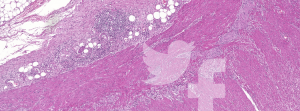Understanding the Social Network Pathologist – The Drive to Share, Discuss and Mingle
microDimensions, a provider of software solutions and services for the processing, visualization, and analysis of microscopic image data, has an interesting article on their blog discussing the use, merits issues and deliverables of social media in pathology. The article is written by Antje Reich and I think touches on key issues of using social media in the practice of pathology and potential pitfalls and pluses. As Antje describes, in the end, I think social media use has and will continue to be used for sharing, informing, educating, presenting, asking and community building to do what Web 2.0 (and what I like to call Pathology 2.0) tools do very well — harness collective intelligence unlike ever before in medicine, particularly in anatomic pathology as an image-rich profession/endeavor. While direct patient outcomes may be difficult to measure via discussion on Twitter or Facebook, I do agree with this article that social media will help all of us to better understand diseases and ability to help patients. Encourage you to read the entire piece by Antje and of course, in the spirit of social media, comment, like and/or share with your colleagues.
 Using the power of social media for professional work isn’t new to pathology. By today, social media channels have become one of the speediest and easiest to use online tools in the disruption of healthcare communication.
Using the power of social media for professional work isn’t new to pathology. By today, social media channels have become one of the speediest and easiest to use online tools in the disruption of healthcare communication.
Despite an initial reservation, by 2017 pathologist around the world have discovered especially Twitter and Facebook as effective platforms to exchange thoughts on the latest technical or regulatory developments in pathology, discuss interesting cases and images with colleagues, and communicate with patients in dedicated support groups. The number of the pathologists engaging in social media – let’s call them ‘social network pathologists’ – continues to grow swiftly. On Twitter alone, there were over 19,000 Tweets on #Pathology in the month of September 2017, leading influencers in the field have thousands of followers and even a formal ontology on Twitter hashtags for pathology subspecialties emerged.
Looking around the web, we find numerous practical how-to guides for the use of social media as medical doctor and pathologist, including tips of how to prevent pitfalls to HIPAA’s regulations. But what are the real drivers for pathologists to publicly share, present and discuss their work and to mingle in these virtual groups?
Is it the need for more expert discussion and exchange, which healthcare IT solutions cannot satisfy? Is it the community spirit or a self-branding and advocating-opportunity for one’s institution or personal career? Or is it a mix of all these reasons? Let’s try to get to the bottom of the most apparent benefits of social media for pathologists and understand what motivates them to ‘read, like and tweet’.
































